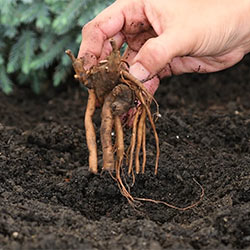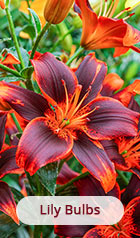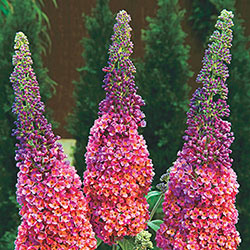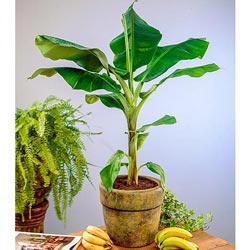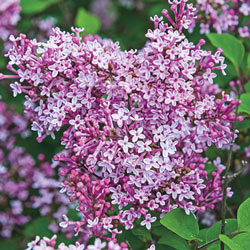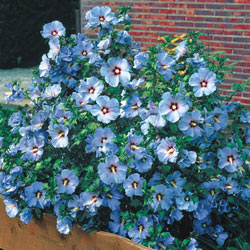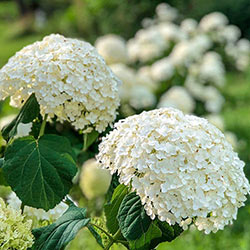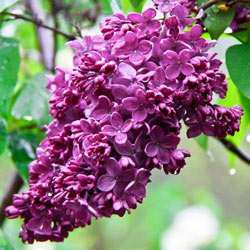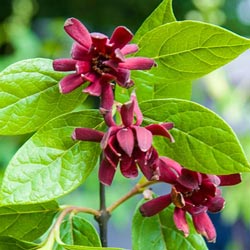Thank You!
We have received your request. You will be notified when this product is in stock.
X
Perk up drab areas with flowering trees or grow delicious produce with our selection of fruit trees. Our shrubs for sale will add year-round aesthetic appeal to your yard, all with enticing colors, textures or fragrances. Our bushes for sale will even help attract hummingbirds, butterflies and other beneficial insects to your garden. Add structure and personalization to your outdoor space with our wide variety of shrubs, bushes and trees, for both sun or shade areas, from Michigan Bulb.
When to plant trees, bushes, or shrubs:
Knowing when to plant trees or bushes is an important element of growing your landscape! Late summer or early fall is the best time to plant trees, shrubs, or bushes. When you plant at this time of the year, soil temperatures are still warm enough to foster new root growth, but the cooler air prevents plants from sapping their energy by growing new foliage. Planting in late summer or early fall provides your shrubbery and trees with the best chance of success.
Planting in the late summer or fall allows your plants to be well-established in time for the next growing season. With early fall planting, trees and shrubs have plenty of time to establish roots before they need to grow, leaf out, and endure the hot summer heat! Because most trees, shrubs and bushes go into a state of dormancy in the winter, they don't need to put their resources into new growth. Winter dormancy allows your trees and shrubs to send energy to their roots, helping them get settled into their new location.
How to plant trees:
Planting a tree—either as nursery stock or bareroot— is a meaningful act. This tree could be with your home for years, or even a lifetime! So, be certain to choose a location where your tree will thrive, and be sure to transplant it correctly to get your tree off to a great start.
As mentioned, the best time to transplant trees is in the late summer or early fall. Planting the tree as it prepares to enter its dormant state allows the tree to spend its energies on its root system, rather than new foliage.
When you choose the site to plant your tree, consider its potential height and width. Avoid placing your tree anywhere where it will eventually be a nuisance or grow into the path of a walkway, driveway, or another tree, shrub or bush. You should also confirm the location of any underground utilities or wires before you start digging, as the roots of any tree will grow deep.
The next steps are dependent upon how the tree was shipped. Many of our trees and shrubs ship as bareroot: small trunks with the roots wrapped in plastic or burlap. These should be planted as soon as possible. Soak the roots of your bare root plants for a few hours before planting. Dig a hole wide enough to hold the roots without crowding them and about an inch deeper than the roots are long, and set the plant into the hole before backfilling.
For balled or burlapped trees, or trees that come in pots, you should break up any tangled root balls. Breaking up or separating tangled roots will encourage them to 'stretch out' and add new growth. Balled trees or container trees may lose some of their roots when dug up at the nursery where they were grown, but this "transplant shock" can be mitigated with careful handling and good site prep. You should dig a hole as deep as the plant's roots, and two to three times as wide. Build a hill in the center of the hole about two-thirds and deep. Set your tree into the hole at the same depth at which it was held in its container or burlap, spreading its roots over the hill. Now, backfill the hole, around the tree's roots, with soil. The trunk flare, where the trunk expands at the base of the tree, should be partially visible after the tree has been planted.
You should fill the hole surrounding the plant gently, but firmly, watering well before completely filling the hole to remove air pockets.. Once the hole is completely filled with soil, water again. During the tree's first growing season, water regularly to keep the soil moist. Do not, however, allow the soil to become water-logged. Mulching around the base of the tree can help retain moisture, but be careful not to use more than 2" of mulch -- piling mulch high could suffocate your tree.
How to plant shrubs and bushes:
Your shrubs or bushes may arrive as bare root plants. Bare root plants are dug from the ground in the fall, after they have gone dormant, and should be planted as soon as possible. You'll want to get those plants into the ground quickly. If you absolutely must delay planting, be sure not to let the roots dry out or rot. You can store the plants in a cool, dry place, or "heel" the roots into the ground by digging a trench in a shady spot and temporarily planting the roots under 6-8 inches of moist soil.
Dig a hole wide enough to hold the roots without tangling them— a foot or two across—and deep enough that the plant can be set into the ground at the same depth to which it was buried at the nursery. Plant the shrub just as deep as it was wrapped during shipping. You can use a measuring tape or the handle of your shovel to compare the depth of the hole to the depth of its packaging.
Loosen the roots (if tangled) of your shrub or bush before planting and soak them for about two hours before putting them into the ground. Check the instructions of your individual plant to determine whether the soil should be amended before planting—some shrubs and bushes require a certain acidity or alkalinity before planting. Some require backfilling with only the excavated soil.
Make sure to plant your bush or shrub in a way that the best-looking side faces the direction from which it will most frequently be viewed. Once you've placed the bush or shrub, it's time to backfill the hole, adding any appropriate amendments. Layer soil back into the hole, patting it down periodically and even adding a small amount of water to create a mud slurry that will settle and cling to the roots. Once the hole is filled, add a 2-3 inch layer of mulch, making sure it does not touch the trunk or branches of the shrub or bush - now water in well.
When to prune trees, shrubs and bushes:
The act of pruning removes branches or stems from plants—and most ornamental trees, shrubs and bushes require at least some pruning. Pruning shapes woody plants like trees and shrubs to manage growth, keep the branches healthy and free of disease, and encourage new flowering, branching and foliage. Of course, poor pruning can cause serious damage to trees, bushes and shrubs, and unplanned pruning can have your favorite plant looking like it visited a bad barber. So, how should you prune your bushes and trees?
To know when to prune, you need to know your plant. When does it bloom, when does it go dormant, and what are the recommended pruning dates for this particular tree, shrub or bush? Check with the nursery or shop where you acquired the plant, call your county extension office, or consult the internet. Most plants do best when pruned after blooming, in either the fall or the spring. Of course, if your tree or shrub has suffered damage or disease, you can remove the damaged parts as soon as possible.
Most trees and shrubs should be pruned in late winter to early spring. Pruning just before spring growth leaves fresh "wounds" open for only a short period of time -- the plant will quickly begin growing again.
For flowering trees and shrubs, pruning time will depend on bloom and growth patterns. Spring-flowering shrubs that bloom on old wood should be pruned in the spring after they are done flowering. This will allow you to enjoy the flowering season and the shrub will have time to initiate new flower buds for next year. Deciduous shrubs that do not flower should be pruned in late winter or early spring before new growth begins. Deciduous trees, as a rule, can be pruned from February to March, before their foliage appears. This gives you a clear view of the tree, allowing for the removal of the appropriate branches to create the perfect shape.
How to trim trees, shrubs and bushes:
Young trees will be amenable to pruning for shape and growth pattern, so start "training" your tree, by trimming, when it's young. When you trim your tree, be sure to remove dead or dying branches and diseased areas. You should also remove entangled or "competing" branches, as well as "waterspouts'' growing straight up. Branches that grow inward, competing with other branches, will eventually chafe the trunk or other parts of the plants. "Suckers" (long shoots that grow out of the base of the tree) should also be removed quickly, before they deplete the energy meant for the tree.
Once established, most trees need only a minimal amount of trimming to keep them shaped -- however, you want to be sure to check for, and remove, damaged or dead branches each season.
Use a good pair of pruning shears for branches up to about half an inch in diameter. Lopping shears provide greater leverage for bigger branches, and hand saws or small chain saws can be used for big jobs. Always keep your pruning tools well-sharpened: doing so will actually help keep you safe and improve your cutting precision!
Small or medium sized branches on the tree can easily be trimmed, cutting at a diagonally downward angle. For larger branches, cut up from underneath the branch, about 6 to 12 inches away from the trunk. Cut about one-third of the way through, then make a second cut about three inches outward, toward the end of the brand, from the first cut. The tree branch will "fall" and you can finish the job by cutting the remaining stub back to the shoulder of the branch.
Shrubs and bushes don't require the same heavy pruning as young trees, but they do require yearly maintenance. Shrubs and bushes can be "thinned out" for good spacing, and broken, diseased, or entangled branches should be cut back. Never cut back more than one-quarter of the live branches on your tree or shrub.
